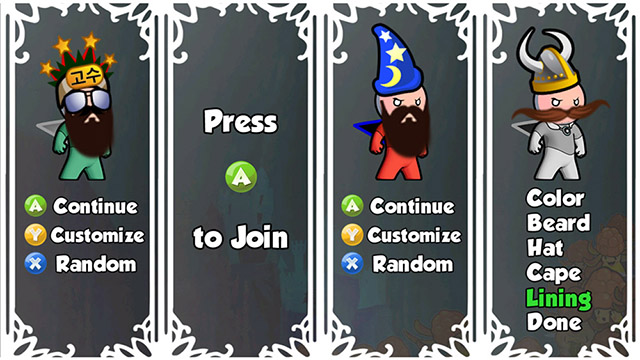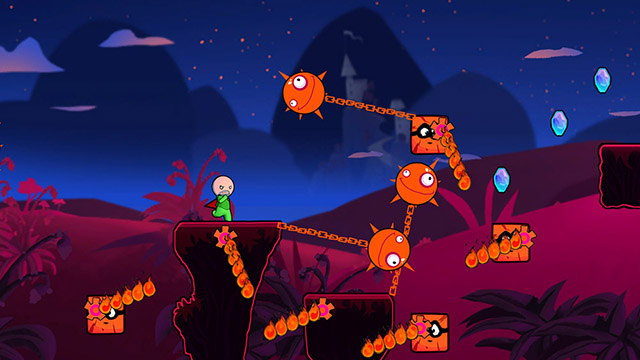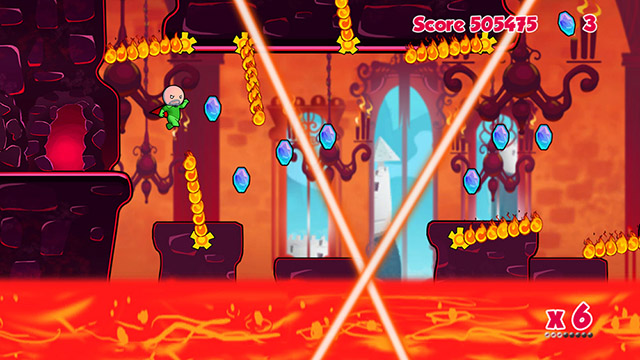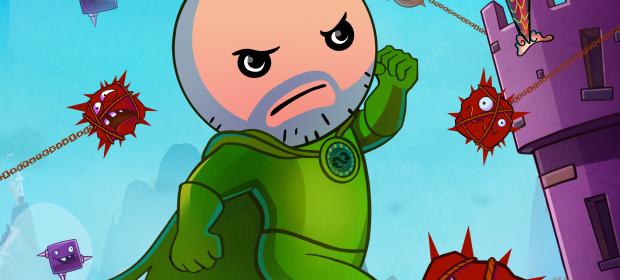From the the dawn of modern videogaming, digital man (and digital woman) has had but one primal desire; to jump on, off, and over things. Thus, the platformer genre was born. Throughout the ages, the genre picked up a power-up (presumably some sort of fungus) and evolved into new and exciting forms; from the single screen arcade games that resided in the primordial soup, to the sidescrolling masterpieces that roam the earth today.
At times, Cloudberry Kingdom feels like the Natural History Museum of platform games; where long-forgotten genre conventions are placed on display for the young’uns to point at and go “Cor, did every platformer have minecarts and ice levels?”
Yes, they did. They all did.

In this Kickstarted platformer’s tiny amount of narrative, the usual bases are covered: Evil king, kidnapped beautiful princess, brave hero, you know the drill. All three are self-aware of the tedium of this constant cycle, but thankfully as you proceed through the game’s Story Mode, these conventions are turned around somewhat.
All you need to know is our hero, Bob (voiced in cutscenes by Hercules himself, Kevin Sorbo) must tackle literally hundreds of levels in Story Mode, split through seven Chapters. The last chapter is titled “The Masochist”, which is exactly the kind of person that will garner the most enjoyment out of this game.
That’s not me saying that Cloudberry Kingdom is bad (because it isn’t); but rather, that it can get incredibly tough (because it really is). It’s a platformer featuring the most simplistic mechanics, but much like the indie darling, Super Meat Boy, it’s about throwing you into short gauntlets of enemies and traps that will destroy you. Earlier levels will feature the odd rotating bars of fire (al a Super Mario Bros.) and the odd buzzsaw. By the time you get to the aforementioned Chapter 7, you’ll be tackling giant dragon-things, billions of buzzsaws, huge areas without solid ground, and more fire than Hell itself.
If that wasn’t enough, Cloudberry Kingdom’s Story Mode constantly shuffles things around, but occasionally changing Bob’s abilities. You may start the game with “Classic” Bob, but you’ll end up with power-ups that either help or hinder your ability to finish each level. Platformer mainstays such as Double Jumps and Tiny Bob, give way to Bob in a Box (clearly inspired by Kuribo’s Shoe from Super Mario Bros. 3) and rather randomly, a Spaceship. Oh yeah, and there’s a type of minecart – I told you the ruddy things were everywhere. These changes will make an appearance throughout Story Mode, which break up the action quite nicely.
I almost forgot: Cloudberry Kingdom cleverly creates levels randomly for you to tackle, using different types and varying amounts of obstacles. But the important thing is that it never gives you a level that is technically impossible to complete. Don’t believe me? Well if you’re finding a level particularly challenging, you have the ability to purchase three different types of aids, using the jewels you pick up in each level. For a small amount, you can see the computer tackle the level so you can get an idea on what you’re supposed to do. Alternatively, for more jewels you could get the game to show you the recommended path through the level, displaying a dotted path and a green blob that travels down that path, to show you where you need to be and when. If you’re still struggling (and believe me, you often will be), you can also slow the action down to give yourself some time to think and react.
The difficulty curve is absolutely perfect. If you saw some of the later levels, you’d probably cower behind the couch in fear, convinced that you’d never possess the ability to navigate the almost bullet hell challenge that these areas present. But Cloudberry Kingdom takes you by the hand from the start, easing you through the earlier levels. It would probably give you a cup of hot chocolate too, right before it punches you in the solar plexus with its granite-hard later levels.

For the superhuman among you who do finish the Story Mode (and it is possible, although it will take time and practice), Cloudberry Kingdom has plenty more to offer platform maniacs. Arcade Mode features several additional modes, everything from score attacks to time attacks, adding to the already massive amount of playable levels.
Finally, a Free Play mode adds potentially infinite replay value. Here, you can set up a series of variables such as difficulty, length, abilities, and the type/amount of enemies, and the game will then come up with a randomly generated level from your options. Much like the rest of the game, you can tackle these levels with up to four players for literally endless fun (including a mode that ties all players with a bungee cord, reminiscent of forgotten Sega 32X platformer, Knuckles Chaotix).
If criticism could be levelled at Cloudberry Kingdom, it could be that for as much as there are an absolute ton of level combinations, after a while you realise that the level design in itself is relatively simplistic, and challenge is created by merely adding more and more enemies/spikes/fireballs/etc. While each level is technically different each time, there comes a point where the levels begin to look and play quite similarly. It’s clearly the experience that is most memorable, not the levels themselves.

Channelling its inner Meat Boy, Cloudberry Kingdom is backed by a number of pumping tracks that border on the incredibly catchy. The sound effects let it down somewhat, especially in certain level types where the constant bouncing sound can be incredibly grating. In between chapters, narrative is conveyed via some uniquely drawn, but very jerky, cutscenes, with dialogue that is so quiet, I didn’t at first realise it was being spoken and thought it was just subtitles. But these shortcomings are likely due to the relatively low budget, and it’s clear that the gameplay itself was the priority – which is something I’m not going to complain about.
VERDICT: Taking elements from almost every platformer from the past three decades, Cloudberry Kingdom is a joyful ode to the genre. While later levels can get incredibly difficult, Pwnee Studios absolutely nailed the difficulty curve and Story Mode completion is attainable for the majority of players, thanks to some well-implemented player aids.
Reservations about the eventual repetition of level elements aside, there are so many ways to play that it’s entirely possible that you’ll keep coming back to this slice of pure platforming for months. It’s every platformer you’ve ever enjoyed, all in one endless package.

SUPERB. This is the mark of greatness, only awarded to games that engage us from start to finish. Titles that score 9/10 will have very few problems or negative issues, and will deliver high quality and value for money across all aspects of their design.





